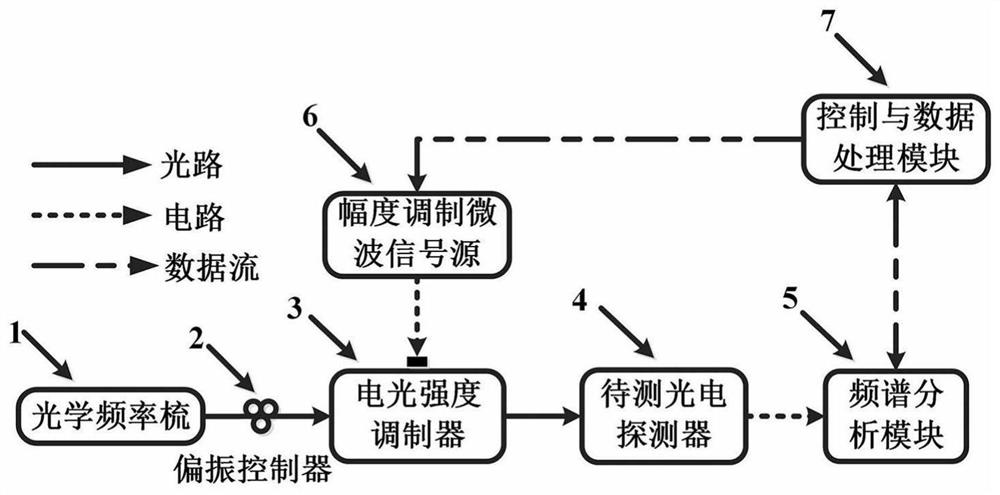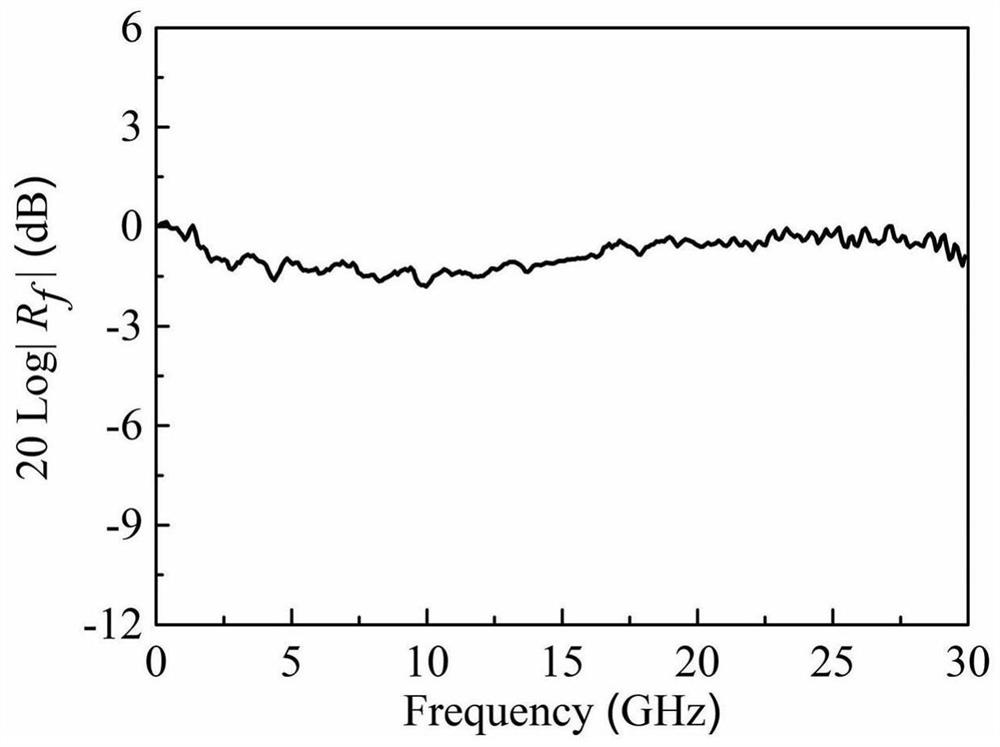Photoelectric response measurement method of a photodetector
A photoelectric detector and photoelectric response technology, applied in the direction of measuring devices, optical instrument testing, instruments, etc., can solve the problems of limited measurement methods and inability to achieve high-precision measurement, so as to eliminate uneven response, realize high-precision measurement, The effect of improving dynamic range and signal-to-noise ratio
- Summary
- Abstract
- Description
- Claims
- Application Information
AI Technical Summary
Problems solved by technology
Method used
Image
Examples
Embodiment 1
[0061] This embodiment measures the photodetector to be tested at a frequency of 9.94GHz (f m ) relative to a fixed frequency of 100kHz (f e ) of the photoelectric response, the repetition frequency f of the optical frequency comb r is 9.954GHz, then the measurement frequency range is segmented according to the repetition frequency, so that 9.94GHz (f m ) satisfies: 0×f r m r , where N=0.
[0062] Use the control and data processing module to set the center frequency f of the amplitude modulation microwave signal source to 4.97005 GHz, satisfying the following relationship: f m =0×f r +2f-f e , namely f=(f m + f e ) / 2, where the amplitude modulation frequency of the amplitude modulation microwave signal source is also 100kHZ (f e ), using the spectrum analysis module to measure the frequency is 9.94GHz (f m ) and 100kHz (f e ) power, recorded as P(9.94GHz)=-60.60dBm and P(100kHz)=-52.82dBm respectively, then according to formula (6) can be calculated to get R(9.94GHz...
Embodiment 2
[0064] This embodiment measures the photodetector to be tested at a frequency of 9.954GHz (f m ) relative to a fixed frequency of 100kHz (f e ) of the photoelectric response, the repetition frequency f of the optical frequency comb r is 9.954GHz, then the measurement frequency range is segmented according to the repetition frequency, so that 9.954GHz (f m ) satisfies: f m =1×f r , where N=1, take R(f r )≈R(f r + f e ), namely R(f m )≈R(f r + f e ).
[0065] Utilize the control and data processing module to set the center frequency of the amplitude modulation microwave signal source as 2.488GHz (f'=f r / 4-0.0005GHz, Δf=0.0005GHz), the amplitude modulation frequency of the fixed amplitude modulation microwave signal source is 100kHZ (f e ), such that nf r +2f'-f e ≈(n+1)f r -2f'+f e , where n=0~N-1, that is, n=0, then the frequency measured by the spectrum analysis module is 9.9541GHz (f r + f e ), 100kHz (f e ), 4.9759GHz (2f’-f e ) and 4.9781GHz (f r -2f'+f...
Embodiment 3
[0066] Embodiment Three This embodiment measures the photodetector to be tested at a frequency of 29.85GHz (f m ) relative to a fixed frequency of 100kHz (f e ) of the photoelectric response, the repetition frequency f of the optical frequency comb r is 9.954GHz, then the measurement frequency range is segmented according to the repetition frequency, so that 29.85GHz (f m ) satisfies: 2×f r m r , where N=2.
[0067] Use the control and data processing module to set the center frequency f of the amplitude modulation microwave signal source to 4.97105 GHz, satisfying the following relationship: f m =2×f r +2f-f e , namely f=(f m + f e -2f r ) / 2, where the amplitude modulation frequency of the amplitude modulation microwave signal source is also 100kHZ (f e ), using the spectrum analysis module to measure the frequency is 29.85GHz (f m ) and 19.9081GHz (2f r + f e ) are recorded as P(29.85GHz)=-63.09dBm and P(19.9081GHz)=-56.15dBm respectively, then according to formu...
PUM
 Login to View More
Login to View More Abstract
Description
Claims
Application Information
 Login to View More
Login to View More - R&D
- Intellectual Property
- Life Sciences
- Materials
- Tech Scout
- Unparalleled Data Quality
- Higher Quality Content
- 60% Fewer Hallucinations
Browse by: Latest US Patents, China's latest patents, Technical Efficacy Thesaurus, Application Domain, Technology Topic, Popular Technical Reports.
© 2025 PatSnap. All rights reserved.Legal|Privacy policy|Modern Slavery Act Transparency Statement|Sitemap|About US| Contact US: help@patsnap.com



